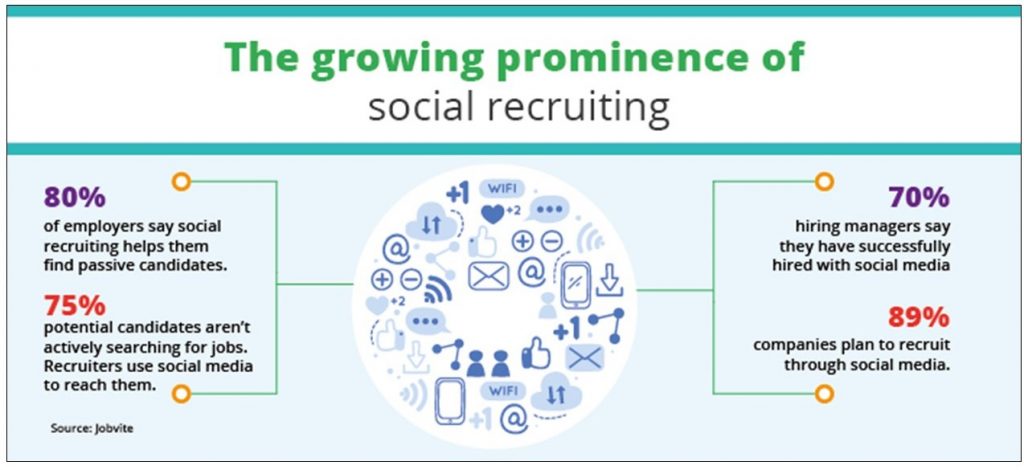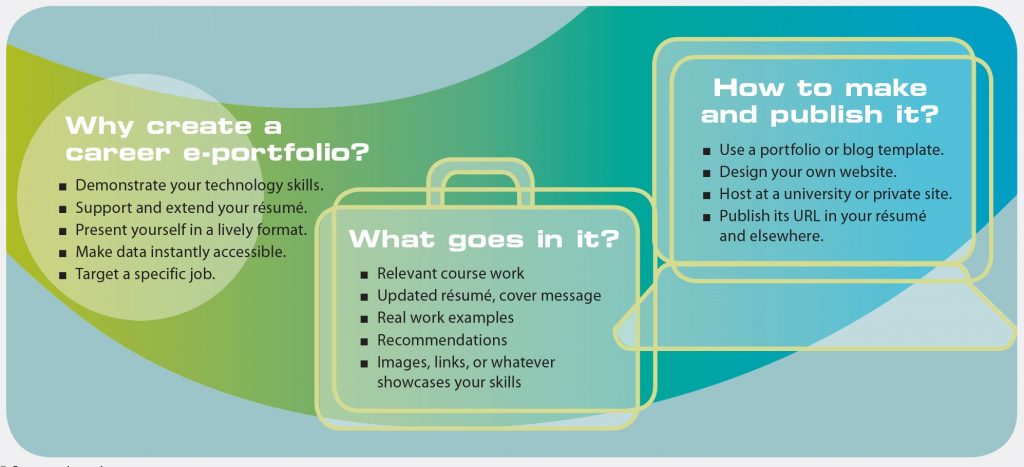B3: The Online Application Process
Artificial intelligence is now the big time-saver for recruiters as the technology can sort through hundreds of applications in a fraction of the time a human can. Applicant tracking systems and other intelligent screening software will most likely be the first to “read” your job application documents. These technologies sort through all applications using keywords to identify those applications that best suit the available job. Therefore, your application documents must be strategically customized for every job posting to which you are responding. For applicants, online job boards, social networks, and mobile technology have become the permanent engines of modern-day job search. The number of apps available to assist job applicants through the job search process is numerous. Thus, knowing how to take advantage of these apps, how to build your online presence, and how to navigate through the online application process are skills the 21st-century job seeker should know.
To get started, view the following video, How to Apply for a Job Online, which provides some basic knowledge on the online job application process.
The Intelligent Application Process
Artificial intelligence has become an important tool in seeking out candidates, screening résumés, running interviews, and selecting new hires. Technology, as the video above indicates, removes many obstacles in the hiring process. In fact, a 2018 survey of trends in the hiring process reveals that 70% of companies have used social media to find and hire employees, and 89% plan to use social media as part of their future hiring process (TalentNow, 2019; see Figure B3.1). Consequently, securing a job in the current and future job market will involve understanding the ins and outs of the online application process.

Figure B3.1 A 2018 survey revealing the role social media are playing in the online hiring process. (TalentNow, 2019).
Knowledge Check
Creating Your Online Presence
Clearly, having or creating an online presence is one important factor in the new intelligent job search environment. Let’s examine how to create an impactful online presence.
Social Network Sites
If you haven’t done this yet, create a professional web presence by assembling a well-developed LinkedIn profile. It is one of the first online profiles that prospective employers check out when considering a candidate. This site and other social networking sites offer plenty of advice on how to make the most of social media platforms, so search a few out to get a picture of the consensus on what makes for a successful profile. A good, current place to start is How to Use LinkedIn Effectively (Doyle, 2021) because this article contains links to several in-depth guides for building each aspect of your profile.
If you’ve already created a LinkedIn profile, show potential employers that you’re fully committed to your profession by continually updating it as your acquire experience and complete projects. Keep building your network by following professionals in your career field and adding content related to your area of expertise. Engage with your online network by responding to posts and connecting with individual thought leaders. Consider your online profile as a space where you can show that you are a motivated professional.
As you gain more professional experience throughout your career, add it all to your online profile to create a master CV (“curriculum vitae,” meaning “course of life” in Latin) from which you can extract targeted résumés for particular job applications. It’s okay if your targeted résumé and CV cover the same content at the beginning of your working life because you won’t have much to put in either; employers will understand that when they see the year you graduated from college. As you gain more experience, be selective about what you include in a targeted résumé; however, your LinkedIn CV will provide employers with a fuller picture of what you’ve been doing with your life. They will be impressed that (1) you were able to present to them a slice of that history relevant to the job at hand, and that (2) you’re so much more well-rounded than your targeted résumé lets on. They’ll see that you have depth.
The Résumé (Online Considerations)
Yes, the résumé is still very important for the online application process. The more closely your résumé matches what an employer’s applicant tracking system (ATS) is looking for, the better your chance of landing an interview and getting the job. Using keywords from job postings is always a good strategy, but modern ATSs are also screening for additional qualities. Ensuring your online résumé contains the following characteristics improves the probability that it will be selected by an ATS. Here are a few tips for customizing your résumé:
Use keywords strategically: Using keywords is good, but using keywords in context is better. That is, use keywords in a manner that ensures the ATS will recognize the mentioned skills as desirable.
Focus on nouns: To attract the attention of hiring managers, focus on nouns. The ATS looks for three types of nouns:
-
- Job titles, positions or roles
- Technical skills or specializations
- Certification, tools used, or specific experience
Vary job title phrasing: Varying the job title can ensure ATS recognition
Highlight the skills section: Adapt the skills section to ensure it responds to desired skills
Use simple formatting: Keep the résumé format simple so as to facilitate easy translation to an online format. Consider converting the basic résumé to a plain-text.
Create customary résumé headings: Using conventional headings will increase ATS recognition
(Business Communications, 2019)
E-portfolios
An e-portfolio provides an opportunity for job seekers to present their skills and talents in a very tangible manner. An e-portfolio allows the job seeker to provide a basic résumé containing links to projects, assignments, videos, social media sites (e.g., LinkedIn) to provide a comprehensive overview of their skills and personality for prospective employers. See Figure B3.2 for an overview of e-portfolios.

Figure B3.2 The why, what, and how of developing an e-portfolio. (Business Communications, 2019)
You can create an e-portfolio yourself by creating a website using free website builders like Wix, Squarespace, Weebly, and WordPress. These sites offer customizable templates that you can adapt to your needs. There, you can store your résumé, project work, letters of recommendation, and other artifacts displaying your qualifications, experience, and education using appealing page designs and imagery. Remember to use imagery that reflects your professional persona or brand.
Video Résumés
Finally, another vehicle for an online job application is the video résumé. This format is becoming a key recruiting tool for many companies. A video résumé allows job applicants to present their skills, qualification, and unique interests in multiple formats. Three skills in particular that are highlighted through this medium include speaking, presentation, and technical skills. For a job requiring such skills, a well-produced video résumé provides an advantage over those applicants who apply in the more traditional manner. With the availability of video and video editing apps, creating a video résumé is well within the capabilities of most college students. Here are some tips to create a video résumé:
- Approach: Be yourself. Explain why you are the best candidate for the job and how you would be an asset to the organization. Include a fun fact about yourself to highlight your individuality and personality.
- Attire: Dress appropriately for the career field; it is always best to dress professionally.
- Focus on content: Customize the video content to respond to or match the specific job opening.
- Limit the duration: Keep the video résumé to 1 – 3 minutes.
Watch the following video for more advise on creating a video resume.
Knowledge Check
Conclusion
The job application process has become one that is highly influenced by intelligent agents. In addition to the traditional job application process, a variety of online apps and other tools provide the motivated and strategic job seeker with a wide selection of resources to optimize chances of landing an interview. These are really exciting times for job seekers willing to use these tools in the online application process.
EXERCISE B3.1
 Even if you are not in the job market yet, becoming familiar with LinkedIn can open your eyes to the kinds of information employers seek and also give you practice at filling in templates such as those in the ATS. It can also afford you the opportunity to engage with leaders in your field through postings and comments. The easiest way to begin is to create your profile. You may want to click on the Settings tab to create the privacy settings that match your comfort level. Then, once you are comfortable with your profile, you can make it public and begin engaging with your community by following companies and leaders in your field.
Even if you are not in the job market yet, becoming familiar with LinkedIn can open your eyes to the kinds of information employers seek and also give you practice at filling in templates such as those in the ATS. It can also afford you the opportunity to engage with leaders in your field through postings and comments. The easiest way to begin is to create your profile. You may want to click on the Settings tab to create the privacy settings that match your comfort level. Then, once you are comfortable with your profile, you can make it public and begin engaging with your community by following companies and leaders in your field.
References
Doyle, A. (2021, April 14). How to use LinkedIn effectively. The Balance. https://www.thebalancecareers.com/how-to-use-linkedin-2062597
Guffey, M., Loewry, D., & Griffin, E. (2019). Business communication: Process and product (6th ed.). Toronto, ON: Nelson Education. http://www.cengage.com/cgi-wadsworth/course_products_wp.pl?fid=M20b&product_isbn_issn=9780176531393&template=NELSON
TalentNow. (2019). Staffing industry trends 2019: Follow the changing industry dynamics. https://www.talentnow.com/staffing-industry-trends-2018-follow-the-changing-industry-dynamics/
Veed Studio. (2021). How to make a video resume [Video]. Youtube. https://www.youtube.com/watch?v=TVg847nZ5-I
Work It Daily. (2017). How to apply for a job online [Video]. Youtube. https://www.youtube.com/watch?v=W-2f5UKQdJ0

